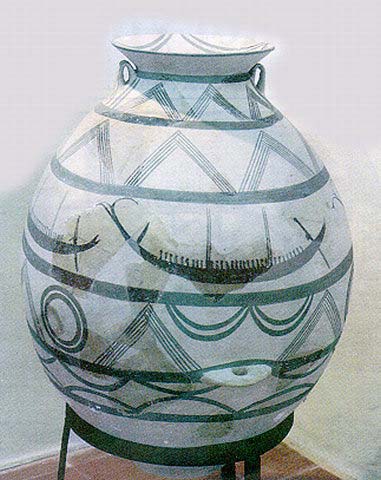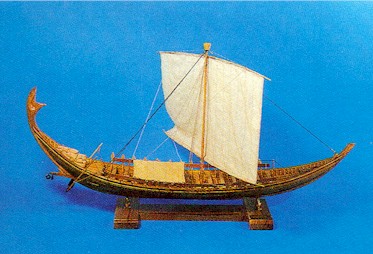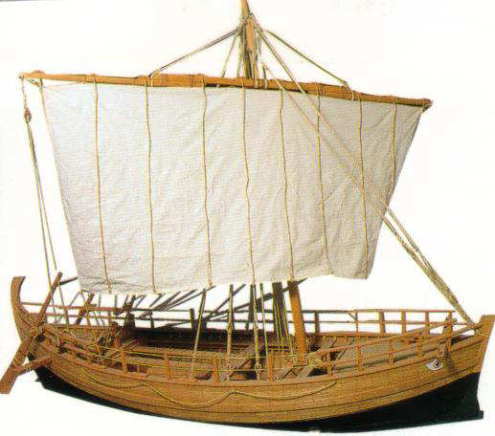Ancient Ships: The Ships of Antiquity
Merchant Vessels and Pleasure Craft of the 2nd and 1st Millennia
BCE as shown in ancient art.


Fresco from the Minoan Culture on Thera Circa 1700 BCE
At the time when ancient histories were not recorded in the written
word it is archeology and art history that give us insight into
the nature of the ancient world. Artifacts found in situ their characteristics
and the comparative analysis of these items along with the scientific
clues they give us are the threads of evidence that lead us to new
conclusions about the times and places where these items were made
and used . Both archeology and art history are disciplines that
lead to powers of observation, records keeping , memory banks of
comparative data and the art of deductive reasoning.
As a prime example of this concept we are fortunate to have a moment
frozen in time on the island of Santorini, which was covered by
the volcanic eruption of Thera in approximately 1625 BCE.
Because the ancient city was covered completely in Volcanic ash
the location became a time capsule waiting to be opened upon discovery.
This event took place before the time a written language could record
the history of this island however the people did record their history
in the form of story boards on elaborate frescos showing the day
to day conduct of the people on the island. The ancient art frescoes
illustrating the use of boats as part of the daily culture of the
Greek Islands rival the art and iconography of Egypt in revealing
the use of the boat in the pre-Mycenaean civilization that occupied
the ancient Greek islands and mainland. This ancient Greek art is
an exact window in time into the 16th or 17th Century BCE. Through
these beautifully rendered paintings we can witness the culture
of the ancient Greek Islands as if from a time machine. Like ancient
Pompeii several ancient Greek islands of the Aegean were covered
with volcanic ash to create a literal time casual that was only
to be opened again in the twentieth century.
This ancient history recorded as frescos on a wall was covered
in volcanic ash preserving a visual record of the culture and Greek
ships from a very specific time in the history of the island.
| Mycenaean Shipping Amphora Dated approximately
1700 BCE |
 |
These frescoes of ancient Greek art illustrate the
use of different kinds of Greek ships for transportation, freight,
fishing, and as pleasure crafts. The dependency of the culture on
the use of boats was dictated by its isolated island geography.
Because of this cultures location in an water environment
the association and use of boats and ships in most activities
within the culture was universal. Under these circumstance we can
assume the evolution of the boat building technologies was of premium
value in this society. One of the most interesting speculations
about this culture is where the seeds of inspiration for this wonderful
art came from.
This art history shows us the fertility of the bull
was celebrated on these islands as in Egypt and Assyria and the
iconography of the boats matches that of artifacts found In the
ancient city of Ur. The best guess scenarios for the seed s
of this culture favors the influences from the Tigris and Euphrates
valleys as well as Egyptian and north African influences. The various
forms of iconography throughout the culture suggests cultural exchanges
through sea faring and trade were a regular event through out the
Aegean Islands. This conclusion is supported by the depiction of
animals that were not indigenous to the Islands such as monkeys
and Oryx antelope. The knowledge of these particular species would
have been dependant on a broad base of travel to foreign lands by
members of this culture.
The sophisticated level reached by the prehistoric
culture of Santorini has lead many people to speculate that this
was the proverbial "Atlantis" which disappeared in a single
day.


 |
A model of the Greek ships used by the Aegean
cultures starting in about 1700 BCE |

Another Scene from the Santorini Frescos
buried in approximately 1625BCE
Read this
Dissertation on the origins of the Sea Peoples circa 1250 BCE
 |
Voyage of the Kyrenia II a modern replica
of 4th Century BCE merchant vessel. Much will be
revealed about his historic era from the Tektas Shipwreck Excavation
|

Kyrenia Model Under Sail

Kyrenia Model
The Ancient Greeks, especially the Athenians, exported olive oil,
wine, and beautiful painted pottery to many different parts of the
Mediterranean. They used these goods to trade for many different
imports. This is a picture of a typical Greek merchant ship used
to transport goods around the Mediterranean. Recent oceanographic
archeological finds are shedding more light on the actual contents
of their cargo’s and the construction techniques used in the merchant
ships of antiquity. It is evident from art history that the Iconography
and its varied sources that the general design of these merchant
vessels remained consistent and changed little over an extended
period of time .
See
Trading Vessel Image from Greek Attic Pottery
The
configuration of merchant vessels changed little in form and
function over time the bucket boat was the norm throughout
the Mediterranean |

|
Previous |
Next | Table
Of Contents

|
